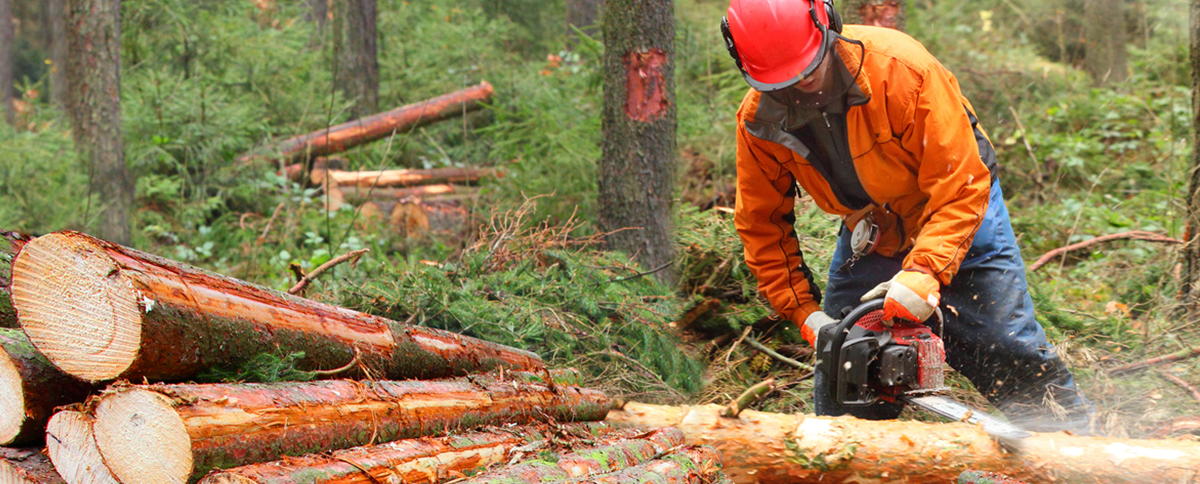- The forestry and logging industry carries high risks, from dangerous machinery accidents to wildfire damage.
- Insurance solutions like inland marine, general liability and commercial auto coverage are essential to protect equipment, workers and businesses.
- Arrowhead’s Forestry & Logging Program offers specialized coverage, including fire suppression and newly purchased equipment protection.
From chopping down towering trees to hauling timber to the mill, the forestry industry presents numerous operational risks that require specialized insurance coverage. Amid rising inflation and a sustained shortage of carriers, enhancing worker safety and maintaining regulatory compliance has become increasingly imperative. Explore the intricacies of protecting your people and business in the face of evolving job-site hazards and inadequate protection measures.
Forestry workers face the highest occupational risks
According to the Bureau of Labor Statistics, forestry crews held the most dangerous jobs in 2022, with a rate of roughly 100 fatal work injuries per 100,000 civilian occupations. A great deal of these risks stem from the specialized machinery used on the job, any of which can cause calamitous accidents. A simple slip with a feller buncher or woodchipper can result in severe injury or death. Additionally, vehicles and equipment can flip or crash into nearby workers.
Related: How to manage logging equipment risks
Dangling dangers
Falling trees and branches are constant overhead hazards. Determining a clear fall direction can be challenging in dense forests, and accidents happen fast, often with little time to react. Separating workers by at least two tree lengths during felling is a standard safety procedure, and intentional planning is a must. Aspects like ensuring a safe fall direction, creating notches and setting correct hinges help fellers create an escape track during felling.
Isolated work environments
Logging often occurs in remote and isolated locations, hindering access to emergency medical services. This unavoidable increase in response times can mean the difference between survival and fatality.
Devastating wildfires
The growing rate of natural disasters in forested areas further compounds the dangers of logging. Wildfires destroyed nearly 988 million acres of land worldwide in 2023, resulting in over 250 documented casualties. These events also took a huge toll on the environment, accelerating climate change through the emission of 6.5 billion tons of greenhouse gases.
The economic necessity of forestry insurance
From a business perspective, forestry operations carry inherent risks. The Occupational Safety and Health Administration, state governments and local agencies heavily regulate the sector. On-site accidents almost always lead to investigations, not to mention potential lawsuits and compensation claims.
Heavy machinery and equipment also represent significant exposure in the event of breakdowns. Between the repair costs and project delays, minimizing your financial risk is critical. Appropriate insurance is necessary to safeguard your business and ensure its long-term viability.
What insurance does my logging business need?
A comprehensive policy should cover all the essentials and any specialty coverage unique to your forestry operations. Below are the key types of logging insurance to consider for effective risk mitigation.
Workers’ compensation
Given the high-risk nature of the job, having workers’ compensation insurance is non-negotiable. This coverage protects you from paying an employee’s medical costs and lost wages for work-related injuries out of pocket. Most businesses that use heavy-duty motors and specialized equipment must carry this insurance.
Inland marine insurance
Your logging and forestry machinery and equipment are some of your most valuable assets. Inland marine insurance offers comprehensive coverage for your machinery, equipment and even timber in transport, ensuring protection from loss or severe damage. Arrowhead’s Forestry & Logging Program provides high in-house underwriting authority, earthquake and flood coverage and competitive premiums, ensuring your machinery and newly purchased equipment are protected.
General liability
General liability insurance protects you from third-party bodily injury or property damage claims. Depending on your policy, it can cover legal fees, settlements and medical expenses. Arrowhead’s program includes property damage to autos and railroad cars not owned by you, as well as timber trespass and the fire suppression expenses.
Commercial auto
For logging operations, commercial auto insurance is crucial. Arrowhead’s program covers vehicles used in logging, offering competitive commissions, in-house underwriting authority and limits up to $1 million.
Pollution liability
Despite the ecological benefits of logging, operations can contribute to pollution, including soil erosion and habitat destruction. Pollution liability insurance protects your company from lawsuits and reparation claims to these environmental impacts.
Umbrella insurance
This type of insurance provides additional liability coverage beyond the limits of primary policies like general liability and commercial auto insurance. It offers an extra layer of protection in cases where claims exceed standard coverage.
Related: Top reasons to offer our Forestry & Logging Program
Enforcing safety best practices on and off-site
An effective safety culture always starts at the leadership level and cascades to the employees for successful implementation. For forestry operations, this means strict adherence to safety best practices all the time. Management must mandate appropriate PPE such as hard hats, safety glasses, gloves and high-visibility clothing when in the woods.
You’re also responsible for implementing regular maintenance schedules for machinery and equipment to ensure they are in safe working condition. Have a system in place for pre-operation checks to identify any potential issues before starting work. Conduct routine worksite inspections to identify hazards and address them promptly.
Protect your forestry and logging company
Insurance, paired with stringent safety protocols, is essential to protecting your business from the myriad potential risks and losses. Arrowhead’s Forestry & Logging Program offers inland marine, general liability and commercial auto insurance coverage designed to address the unique challenges of the forestry industry. Talk to your agent about securing sufficient coverage for your business today.

